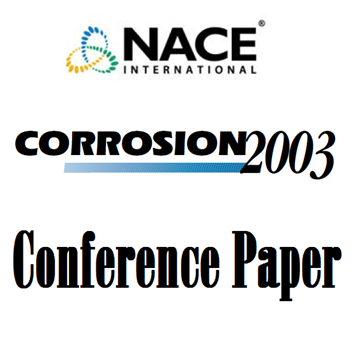Search
Products tagged with 'copper'
View as
Sort by
Display
per page
03269 Observations of Corrosion of Electric Resistance Welded Galvanized Steel Pipe in Domestic Potable Water
Product Number:
51300-03269-SG
ISBN:
03269 2003 CP
Publication Date:
2003
$20.00
51316-7265-Corrosion Behavior of Cr and Cu Containing Low Alloys Steels in Solution
Product Number:
51316-7265-SG
ISBN:
7265 2016 CP
Publication Date:
2016
$20.00
51316-7267-Impact of Microstructure on Hydrogen Solubility and Diffusivity in UNS 07718
Product Number:
51316-7267-SG
ISBN:
7267 2016 CP
Publication Date:
2016
$20.00
51317--9719-New Yellow Metal Corrosion Inhibitors Targeting Surface Chemistry of Industrial Systems
Product Number:
51317--9719-SG
ISBN:
9719 2017 CP
Publication Date:
2017
$20.00
51318-10586-Mechanistic study of microbiologically influenced corrosion
Product Number:
51318-10586-SG
Publication Date:
2018
$20.00
51318-10810-Nickel-based Alloy UNS N06845 with Superior Localized Corrosion Resistance for Sour Environment
Product Number:
51318-10810-SG
Publication Date:
2018
$20.00
97435 Experimental Study of the Erosion-Corrosion of Copper and Copper- Nickel Alloys Using a Submerged Impinging Jet
Product Number:
51300-97435-SG
ISBN:
97435 1997 CP
Publication Date:
1997
$20.00
Calcium Carbonate Biofouling In The Presence Of Heavy Metals
Product Number:
51321-16606-SG
Publication Date:
2021
$20.00
Copper Antifouling Coatings - Greener then the Headlines. The Latest Regulatory Happenings and How They can Affect You
Product Number:
41212-665-SG
Publication Date:
2012
$20.00
Crevice Crrosion of Copper as an Engineering Barrier of High-level Radioactive Waste Containers
Product Number:
51317--9162-SG
ISBN:
9162 2017 CP
Publication Date:
2017
$20.00
Effects of Alloying Elements for Resistance to Naphthenic Acid Corrosion of 18Cr Austenitic Stainless Steels
Product Number:
51317--9057-SG
ISBN:
9057 2017 CP
Publication Date:
2017
$20.00
Failures of Brass Components in Water and Steam Systems
Product Number:
51317--9123-SG
ISBN:
9123 2017 CP
Publication Date:
2017
$20.00
- 1
- 2












